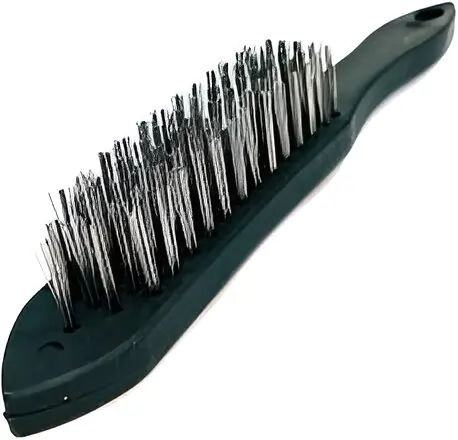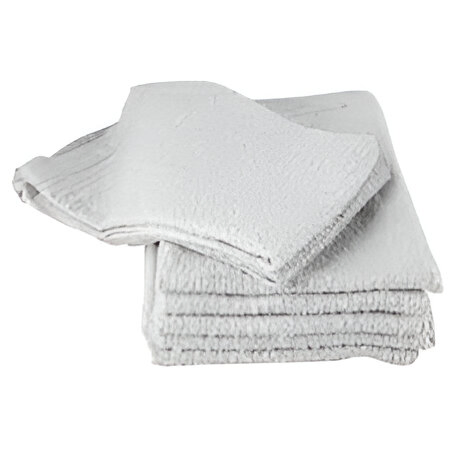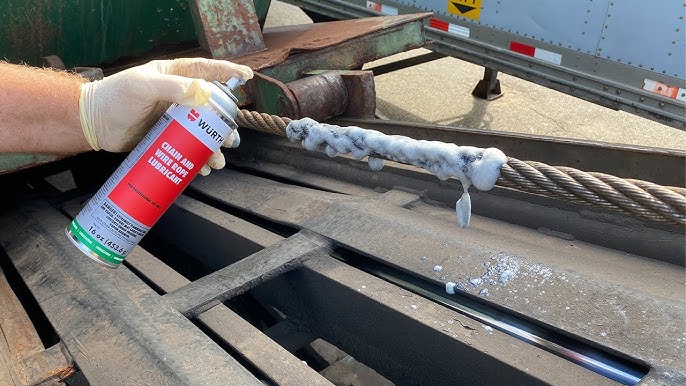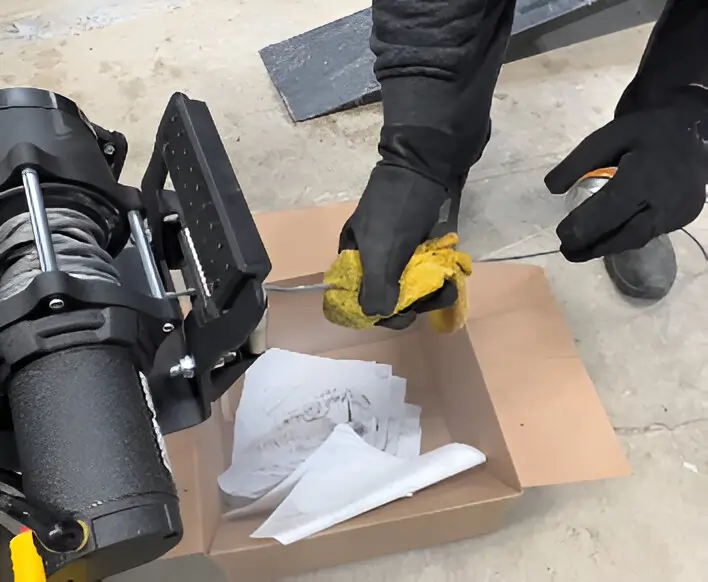Keeping your winch in top shape is essential for it to perform well, especially if you’re into off-roading or rely on your winch for heavy-duty tasks. Over time, dirt, mud, and grime can clog up your winch, and without proper lubrication, the moving parts can wear out quickly.
Cleaning and lubricate a winch cable regularly not only helps prevent breakdowns but also extends the life of the equipment.
Tools You’ll Need to Lube a Winch Cable
Before you start, gather the following tools and materials:
Lubricant:

Choose a suitable type based on the environment your winch is used in.
Wire Brush:

For cleaning the cable before applying the lubricant.
Protective Gloves:

To protect your hands from sharp cable strands and chemicals.
Rags or Paper Towels:

For cleaning and wiping off excess lubricant.
Quick summary
Lubricate a winch cable by cleaning it thoroughly, applying a suitable lubricant evenly, and storing it properly. Regular lubrication reduces friction, prevents rust, and ensures smooth operation.
Step-by-Step Guide to Lubricating a Winch Cable

Lubricating a winch cable might seem like a straightforward task, but doing it correctly is key to maintaining your winch’s performance and longevity.
Let’s go through the process step-by-step, ensuring each detail is covered so your winch operates smoothly and reliably when you need it most.
Step 1: Prepare Your Work Area
Before you begin, make sure your workspace is well-prepared. Choose a location that’s well-ventilated to avoid inhaling any fumes from the lubricant or cleaning agents.
Ensure the winch is completely turned off and secured in place, either by locking the brakes or engaging the clutch. This prevents any accidental movement while you’re working.
Next, unspool the winch cable completely. This step is crucial because it allows you to access the entire length of the cable. By fully extending the cable, you can inspect it thoroughly for any damage, dirt, or rust and apply lubricant evenly across every inch.
If the cable is tightly wound around the drum, use the winch controls to carefully unwind it while guiding the cable to prevent kinks or tangles.
Step 2: Clean the Cable
Cleaning the cable is an essential step that prepares the surface for lubrication. Start by using a wire brush to remove any loose dirt, mud, or rust that has accumulated on the cable.
Focus on areas that are more likely to collect debris, such as near the hook and the sections that come into contact with the drum.
If there are stubborn rust spots, you might need to use a rust remover or a light solvent. Spray it on the affected areas and let it sit for a few minutes before scrubbing with the wire brush again. Be thorough, but gentle, to avoid damaging the cable strands.
Cleaning not only allows the lubricant to adhere better but also reveals any signs of wear or damage that might need attention.
After brushing, wipe the cable down with a clean rag to remove any remaining dust and debris. This final wipe-down ensures that no particles are left to interfere with the lubrication process.
Step 3: Apply the Lubricant Evenly
With the cable cleaned and prepped, it’s time to apply the lubricant. Choose a lubricant suited to your needs, whether it’s penetrating oil for general use, silicone spray for water resistance, or a dry film lubricant for dusty environments.
Begin at one end of the cable, usually at the hook, and work your way along its entire length. Spray or apply the lubricant directly onto the cable, making sure to coat it thoroughly. Use your gloved hands or a rag to work the lubricant into the strands.

This step is important because the lubricant needs to penetrate deeply between the strands to reduce internal friction and protect against rust.
Continue this process until you’ve covered the entire cable. Don’t forget to lubricate the hook and any exposed metal parts, as they are also susceptible to rust and wear.
If the cable has any fittings or joints, make sure to lubricate these as well. The goal is to provide a uniform coating that protects every part of the cable.
Step 4: Check and Lube Other Moving Parts
While you’re focusing on the cable, it’s a good idea to inspect other components of the winch that might need lubrication. Check the winch drum, which the cable winds around, as well as the gears and any moving joints.
If these parts look dry or show signs of wear, apply a light coat of lubricant. Use a different type of lubricant if necessary, based on the manufacturer’s recommendations for these components.
Properly lubricating the drum and gears not only helps the cable wind and unwind smoothly but also reduces the overall strain on the winch motor.
Pay attention to the winch’s clutch and brake mechanisms as well. Although they don’t need to be soaked in lubricant, a small amount can help maintain their functionality.
Step 5: Test the Winch
Once the cable and other components are fully lubricated, it’s time to test the winch. Slowly wind the cable back onto the drum, watching for smooth, even retraction.
Run the winch through a few cycles—extending and retracting the cable—to ensure that the lubricant is evenly distributed.
Listen carefully for any unusual noises, such as squeaking or grinding, which could indicate that more lubrication is needed or that there’s an issue with the winch. Also, feel the cable as it retracts. It should move smoothly, without resistance.
If you notice any stiffness or jerky movement, check the cable again to see if more lubricant is required or if there’s dirt or rust still present.
This step not only helps spread the lubricant thoroughly but also gives you peace of mind that everything is functioning properly before you use the winch in a real-world situation.
How Often Should You Lube a Winch Cable?
The frequency of lubricating your winch cable is crucial for ensuring optimal performance and longevity.
The interval at which you should lube your cable largely depends on two main factors: how frequently you use your winch and the conditions it operates in.
Regular Usage in Harsh Conditions
If you frequently use your winch in challenging environments—such as muddy trails, sandy terrains, or areas with a lot of water exposure—it’s essential to lubricate the cable more often.
In such conditions, dirt, grit, and moisture can quickly strip away the protective layer of lubricant, leaving the cable vulnerable to friction and rust.
For regular off-roaders or those who use their winch in marine settings, it’s recommended to lube the cable every few months.
This frequent lubrication helps maintain the integrity of the cable and prevents it from wearing out prematurely due to the abrasive and corrosive elements it encounters.
Occasional Use in Mild Conditions
If you only use your winch occasionally, like for light-duty tasks or in relatively dry and clean conditions, the cable won’t require lubrication as often.
In these cases, lubricating the cable once or twice a year is generally sufficient. This schedule will keep the cable protected from rust and ensure smooth operation without overdoing it.
However, it’s still important to inspect the cable regularly, as factors like weather changes or storage conditions can still affect its condition.
Signs Your Winch Cable Needs Lubrication
Regardless of how often you use your winch, you should always be on the lookout for signs that your cable needs lubrication. Here are some key indicators:
- Visible Rust: Rust is a clear sign that the cable lacks sufficient protection. If you notice rust forming on the surface, it’s time to clean and lube the cable immediately to prevent further corrosion.
- Squeaking or Grinding Noises: Unusual sounds during operation usually indicate increased friction between the cable strands or moving parts. This is a signal that the cable is not adequately lubricated.
- Stiff or Difficult Operation: If the cable feels stiff or doesn’t wind and unwind smoothly, it’s likely due to a lack of lubrication. This stiffness can strain the winch motor and gears, leading to potential damage if not addressed.
Common Mistakes to Avoid When Lubricating a Winch Cable
While lubricating a winch cable is generally a straightforward task, there are some common mistakes that people often make.
These mistakes can reduce the effectiveness of the lubrication or even damage the cable and winch system. Here are the key errors to watch out for:
Over-Lubricating
It might be tempting to think that more lubricant will offer better protection, but over-lubricating a winch cable can actually cause problems. When too much lubricant is applied, it can attract and trap dirt, dust, and grime.
This sticky build-up can clog the cable strands, making it harder for the cable to move freely. It can also gunk up the winch drum, leading to poor performance and potentially damaging the winch mechanism.
To avoid this, apply a moderate, even coat of lubricant. Make sure the lubricant penetrates into the strands but isn’t dripping off the cable.
After applying, use a clean rag to wipe off any excess. This will leave a protective layer without the risk of attracting too much debris.
Under-Lubricating
On the flip side, under-lubricating is just as problematic. Not using enough lubricant leaves the cable exposed to friction and wear, especially in high-stress situations where the cable is under heavy load.
Without adequate lubrication, the individual strands of the cable can rub against each other and against the drum, leading to increased wear and a higher likelihood of fraying or snapping.
Make sure to cover the entire length of the cable evenly, paying extra attention to areas that see the most friction, such as the points where the cable wraps around the drum. A thin, consistent layer is usually sufficient.
Using the Wrong Lubricant
Not all lubricants are suitable for winch cables, and using the wrong type can be detrimental. For example, thick greases designed for automotive parts can clog the cable strands, attract dirt, and reduce the flexibility of the cable.
Some lubricants are also not formulated to withstand the specific conditions a winch cable faces, such as constant tension and exposure to water or mud.
Always choose a lubricant that is designed for cables or wire ropes and is appropriate for the environment your winch operates in.
Penetrating oils, silicone sprays, or dry film lubricants are generally good choices, depending on the specific conditions. Avoid anything too thick or heavy, as these can create more problems than they solve.
By avoiding these common mistakes and following a regular maintenance schedule, you’ll ensure that your winch cable stays in optimal condition, providing reliable performance whenever you need it.
Proper lubrication not only extends the life of the cable but also reduces the risk of winch failure during critical operations.
How to Store a Lubricated Winch Cable Properly
After lubricating your winch cable, proper storage is key to maintaining its condition. Fully retract the cable and, if possible, cover it to protect it from dust, dirt, and moisture.
If your vehicle is stored outdoors, use a winch cover to shield it from rain and sun exposure. This will help preserve the lubricant’s effectiveness and prevent rust or corrosion.
FAQs
How do I know when my winch cable needs lubrication?
If the cable is stiff, squeaky, or showing signs of rust, it’s time to apply more lubricant.
Can I use regular oil to lube my winch cable?
Regular oil doesn’t provide the long-lasting protection needed for winch cables. Use a penetrating oil, silicone spray, or dry film lubricant instead.
What should I do if my winch cable still feels stiff after lubrication?
Check for any debris or rust that might still be present. If the cable is clean and still stiff, you may need to reapply the lubricant or inspect the winch for mechanical issues.
Is lubrication necessary for synthetic winch ropes?
No, synthetic winch ropes don’t require lubrication. However, you should still maintain the winch drum and other moving parts.
Conclusion
Lubricating your winch cable is a simple yet essential task that ensures smooth operation and prolongs the life of your winch.
By choosing the right lubricant and applying it correctly, you protect the cable from friction, rust, and wear.
Regular maintenance like this keeps your winch ready for action, whether you’re off-roading, working, or recovering a vehicle in tough situations. Make it a habit, and your winch will serve you well for years to come.

